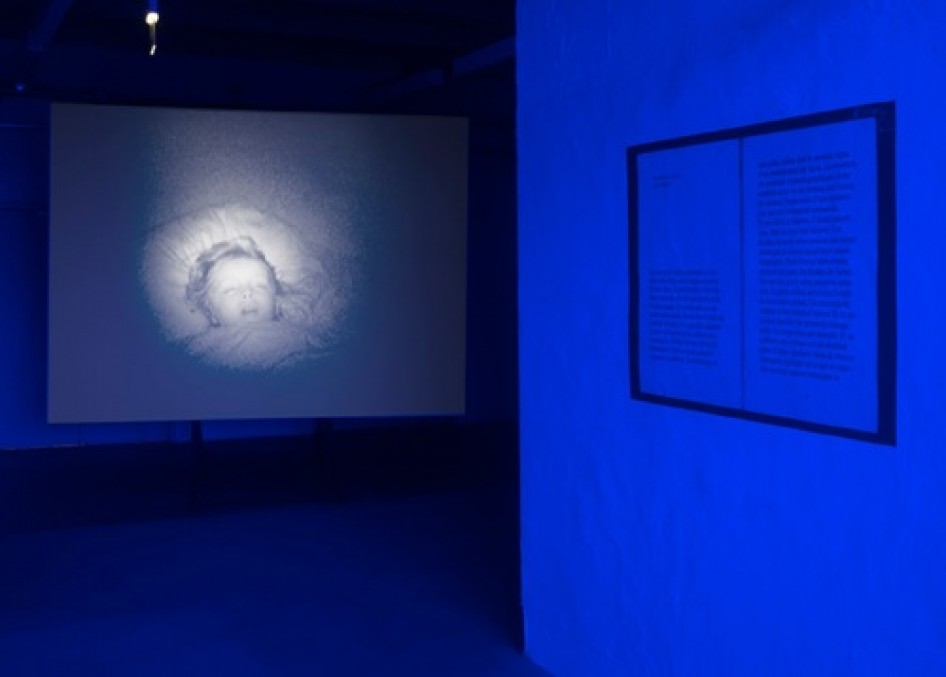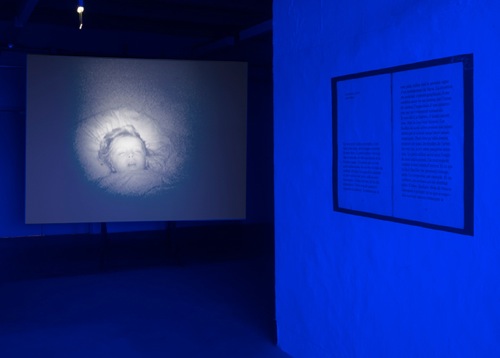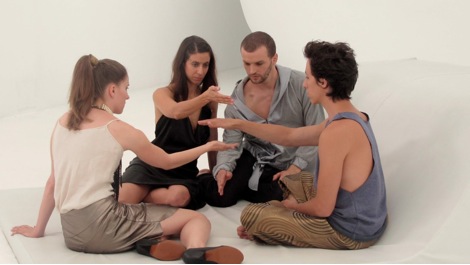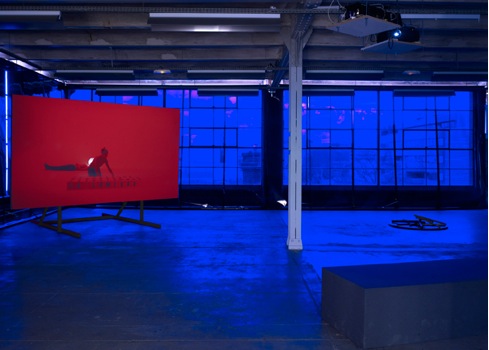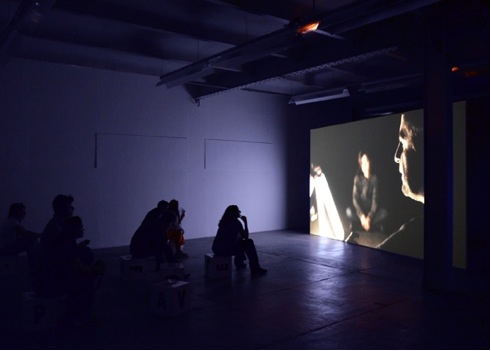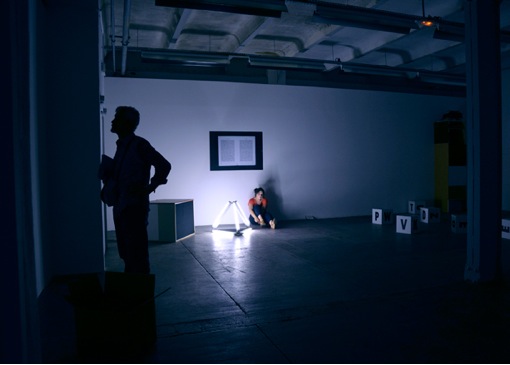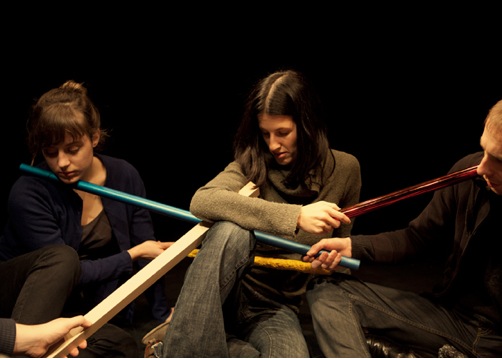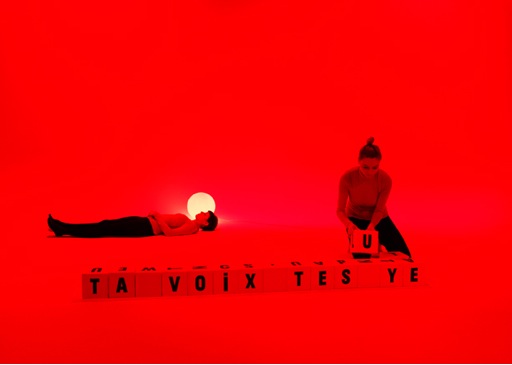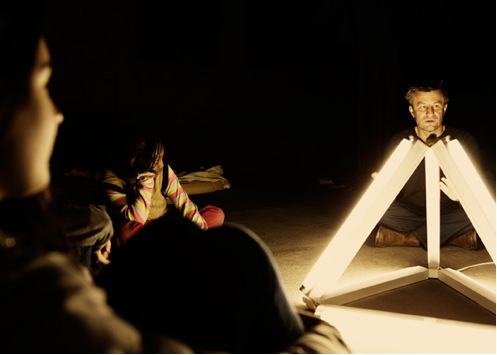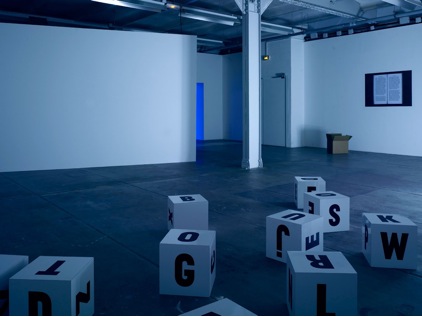Because attending an exhibition with an imposed duration is a bit like when he’s ready to launch into a film, concert or play and has a specific time period set apart for that, outside the usual sequence of time. The duration indicated for a visit to ‘Séances’ (‘Sessions’)is forty minutes, and that’s probably the time it will take before he accepts to go with the flow until the lights go out and the whole thing’s over. It’s also the time he’ll need to gradually let go of the idea of an ‘organized’ visit, to agree to wander from one place to another without worrying about chronology or logic. The idea of these sessions is not so much to grasp a logical sequence as to attend a disorganized series of sensations, atmospheres and unrelated events whose overall order (if it exists) will escape him for the moment. He’ll soon realize that he won’t get to see everything, that there are missing links, and that any connections that occur will depend on his random wandering. His attention will be attracted by the sound of a voice in a nearby room, or the luminosity of a film that’s just started in another. As he feels his way forward, he’ll remember doing the same in an unfamiliar house when he was a child, trusting to the unrelated sources of light and sound produced by the adults until late at night. It’ll be dark here too, and the poles of attraction will be images or sounds that are sometimes desynchronized, screens that alternately light up and fade out, extracts of texts displayed on the wall, sculptures that can hardly be distinguished in the dark, others that resemble pieces of furniture. Some elements will come into action when others switch off (and sometimes that will happen simultaneously), some will require more attention than others, some will seem especially important while others will be more discreet and may escape his notice. And so a narrative will emerge: the story of a night without end, a darkness that fell and never lifted; some people no longer even expect this night to end as it’s become an integral part of the world around, imposing its presence on those who still live there. Elsewhere, a sleeping child will be discreetly watched over by a camera in Nightshot mode whose digital zoom will invade the image and atomize the child’s face into a swarming mass of pixels. Perhaps to combat the lethargy of the night, some people will tell a story around an electric camp fire: the tale of a night without end; others will play touch-and-feel games in bright artificial daylight. Elsewhere, the elliptical story of a dream will be told in phrases full of love and hope. This everlasting night pervades every creature and thing that dwells within it. He may choose to stay, or perhaps he’ll move on—to listen to the loud beating sounds, to read a text from the Bibliothèque des fragments (Library of Fragments), to look through the bay windows at the city with its red trees, cloaked in a veil of midnight blue; or maybe he’ll close his eyes and connect these bits and pieces to memories of his own, also outside the usual sequence of time.
Paris, June 20, 2012,
Dear Claire,
The ‘Séances’exhibition ended at the Crédac art center on June 3. It always feels strange when an exhibition’s over. Suddenly, I won’t be making my regular trips to the Crédac any more, I’ll lose my familiarity with the place and the team… but I also have to come to terms with the fact that the items presented will no longer be shown, or not in that particular configuration anyway. So a little nostalgia to begin with, though at the end of the day I have few regrets because, of all my projects, ‘Séances’ is the one that I’ve been most fully and successfully involved in. It’s the one I’ve gone back to see the most often too, because of all the encounters and exchanges—with friends, professionals or project collaborators, but mostly because it was always such fun to plunge back into the time and space of ‘Séances’.
Since the exhibition finished we haven’t had a chance to continue the discussions sparked by the project, so I’d like to take advantage of this letter to share some (rather disjointed) thoughts with you.
Where should I start? The notion of fragments and their various arrangements was one of the themes and structural elements of ‘Séances’, so it doesn’t really matter… but maybe I’ll begin with something that threatened to be a problem, both technically and financially, but turned out to be an advantage— which was a wonderful surprise. I’m referring to the bay windows at the Crédac, the light they let into the exhibition space, and the problems that caused regarding the video projection of the five films. We agreed from the outset that it would be a shame (and a financial impossibility) to cover those expanses of glass with picture rails. I explained to you that I hadn’t envisaged a particular exhibition space when I’d first imagined the ‘Séances’ project, but had thought (vaguely at first) of the generic white cube (or its black equivalent) for the video projections, or at least of the sort of windowless space that most exhibition venues provide. Digressing for a moment to return to the genesis of ‘Séances’ and to an essential (and for me, new) point: I was at the initiative of the project, and presented it to a number of people including you. Rather than adopting the traditional, passive role of the artist who waits for an exhibition offer, I turned the tables, making an offer, just as a filmmaker contacts a producer and a distributor to present a scenario, inviting them to join forces with him in order to produce and distribute his film. And you know how much I would have liked to involve several art centers, so that ‘Séances’ could tour and be shown in different places, the way it happens in the world of music or the performing arts. Institutional inertia and force of habit, hesitation or simply lack of interest have made that impossible so far…. but I live in hope!
Equally importantly, this initial spark came with a sort of dynamism I’ve never known before: I addressed myself not only to you, the director of an art center, but also to dancers, writers, graphic designers, musicians… And I was amazed by the enthusiasm and generosity of the participants. I don’t know whether the pleasure I got from these exchanges and partnerships was perceptible to spectators, but I do know that it pervaded the whole project.
But, to get back to the origin of the project, ‘Séances’ stemmed first and foremost from the desire to develop some of the dominant aspects of the work I’ve been doing in recent years: I wanted to present a décor-landscape that the visitor could wander around and that would resemble a show as much as an exhibition; the notion of duration was inherent in this idea. I also wanted a story to be told using something other than images or words and, finally, I wanted to provide a set of disparate elements that the spectator would piece together. In relation to previous works, ‘Séances’ intensifies the role offered to the spectator: although the latter never passively receives an artist’s proposition but always participates actively in making sense of an artwork, I wanted to exemplify and extend this active role with ‘Séances’, putting the artist’s own involvement in the work on an equal footing with that of the spectator.
That was a lengthy digression, and I’ve come a long way from the bay windows… So, it was because of the strong natural light that I had to find a solution—a technical one above all—to make the video projection possible. The use of blue gelatin film turned out to have three advantages: it made the space sufficiently dark, it created a day-for-night atmosphere in the rooms, and it transformed the surrounding urban landscape into a film set. So something that was basically a constraint ultimately generated a visual proposition. You told me it gave you a whole new perception of the view from the Crédac windows, and that visitors were highly sensitive to this visual outlet. The ‘Séances’exhibition was bathed in a bluish color which I think added to its intensity and strangeness but, above all, the unexpected view of the exterior provided both a real and a symbolic opening that the original project probably didn’t have to the same extent. And it’s this opening which […]
The film Brouillard-Enfant is 40 minutes long, and the duration of ‘Séances’ was based on this timeframe. A very slow zoom-in transforms the face of a sleeping child, filmed in Nightshot mode, into a completely abstract gray-green video material. The film was shown in the lobby of the Crédac, so it was the first and last image that visitors saw. On the right-hand wall is the first part of the text by Gaëlle Obliegly, which visitors could read in full in the Bibliothèque des fragments; they could also hear it read aloud by Jean-Yves Jouannais in the film Conte de feu de camp (Camp fire tale).
This is an image from Une partie d’Assemblée. Chronologically speaking, this was the first film I made, in September 2011. Three days of rehearsals, then two of shooting in an immaculate empty apartment designed by François Roche. Neither the actors nor I know the rules of the game Assemblée, but I wanted to give the impression that there were rules nonetheless. For this film, I wanted a rather cold, almost advertising aesthetic with slow circular tracking shots. The relationships between the characters are rather superficially and narcissistically erotic; they touch each other a lot, but never really make contact.
‘Allowing the various components of ‘Séances’ to exist on the same level means suspending their interpretation, asserting my desire not to satisfy the spectators’ request for meaning but to ask them to do the work.’ This is an extract from the working document I sent Claire le Restif when I first proposed the project. And the image is a view of the room with the Bibliothèque des fragments and the Feu de camp mikado, the room in which the films Les Mots-Nuits and Une partie d’Assemblée were shown, together with the soundtrack by Aymeric Hainaux. This was the room in which the sensations of ‘day-for-night’ and opening onto the exterior were the strongest.
This is the room in which the film Conte de feu de camp was shown. People watching other people watching someone telling them a story. The spectators sat on cubes with letters on their sides—the same cubes as those that were manipulated in the film Les Mots-Nuits. This is one of the many examples of an object present in a film reappearing in sculptural form in the exhibition. Likewise, the protagonists of Conte de feu de camp sit around a camp fire made of fluorescent tubes which was present and illuminated in this same room when the film wasn’t being shown.
Basically, I wanted to propose something in the nature of experience. The experience of a duration, a space, a series of visual, sonic and textual elements, but above all, the active experience of their interconnection, their piecing together.
‘Passing sparks, disjointed fragments, sparks with scarlet fissures. Not fragments of a whole, but of a power, of an unknown and colorful celebration.’
The words are those of Didi-Huberman, speaking of Fra Angelico, and the image is from the filmNaissance du Mikado. Again, there’s a porosity between the images and the sculptures: the sticks the characters use to caress each other also appeared in the form of a camp fire, heaped on the floor in another room.
An image from the film Les Mots-Nuit. The two girls take turns writing verses from the text that Anna Karina reads in Alphaville—a text that Godard put together using fragments of poems by Éluard.
‘Alpha-60: Do you know what transforms darkness into light?
Lemmy Caution: Poetry.’
The figure of the camp fire is a recurrent motif in ‘Séances’. Partly because it’s a light source, of course, but also because it generates the shape of a circle: people sit in a circle around the fire, everyone facing everyone else. The camp fire is also the place and time for telling stories.
‘Olivier Père: Do you think courage is synonymous with self-confidence?
Leos Carax: If you have total confidence in yourself, you don’t need courage. But when I look back at the kind of child I was, I wasn’t self-confident. I had confidence in the fact that I had to try things. When I was a child (I don’t remember how old exactly, and I expect it’s true of all children), I’d go downstairs munching an apple and I’d hear a voice saying ‘He went downstairs, munching an apple.’ I’m not a religious person, but when you have that voice, that kind of confidence in yourself, you’re followed, you’re a story… a story that has to be written. By you alone. Realizing that—that you have to write your own life—could be the beginning of courage…’

